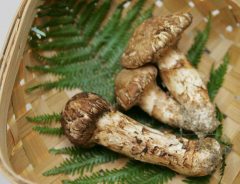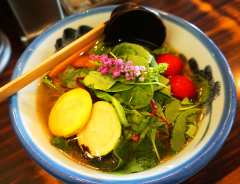- Source:
- © JAPAN Forward
- Tags:
- JAPAN Forward / Vegan / vegan cooking / vegan cuisine / vegan food / veganism
Related Article
-

Japan’s onsen are famous, but its notenburo are even better!
-

Delicious vegan deli plates now available at casual dining restaurant CITYSHOP Shibuya Cast
-

Living in the city? Try hand picking at strawberry farms
-

Kanazawa’s Gift: The World Discovers the Autumn Flavor of Japanese Matsutake
-

Riding the Steam Train Chichibu Paleo Express
-

5 Best Vegetarian and Vegan Restaurants in Tokyo



(By Jasmine Ortlieb for JAPAN Forward)
Being a vegan in Japan can sometimes be quite tricky, especially with popular dishes which are fish and meat-based, like sushi, ramen, and yakiniku. Broth derived from bonito is a key ingredient in the seasoning in nearly everything, including things which appear vegetarian-friendly, such as vegetable and tofu soups, noodle dishes, and nearly every processed food product.
With the best intentions, sometimes misconceptions regarding the concept of vegetarianism and veganism occur. For example, I went to a cooking class advertised as “vegan-friendly,” and the instructor sprinkled bonito shavings over the fried tofu.
© JAPAN Forward
On the other hand, I have found that it is not only possible but enjoyable to live and be happy as a vegetarian and even as a vegan in Japan. Shojin ryori, or traditional Buddhist cuisine, conventionally uses no animal products, has been eaten at temples since around the Heian and Kamakura periods*.
Generally high vegetable and soy consumption, along with a low intake of milk, makes Japanese cuisine suitable to vegetarianism, especially when cooking at home. Also, vegetarian and vegan options are increasing when dining out.
Whether or not you are vegetarian or just want to get more vegetables into your diet, below are some things to keep in mind with cooking and nutrition.
© JAPAN Forward
* About Shojin Ryori: These days, some of the regulations regarding use of fish, eggs and dairy have been relaxed so it’s worth checking or asking beforehand for your dietary needs when going to a modern shojin ryori or a temple as the menu might not be suitable for vegans.
1) Keep Your Diet Simple
With the lack of special vegan and vegetarian ingredients, your diet will likely consist of simple, whole food ingredients. Less additives and added chemicals are better for your health, but it does take longer to make food from scratch.
For protein, try all the varieties of tofu Japan has to offer, including soy meat, beans, and nuts. If you can handle it, natto (fermented soybeans) is highly nutritious. Lentils, seitan, and other vegan proteins are rarer but can be found at specialty stores. Soy meat can be bought at most supermarkets and is particularly delicious fried.
© JAPAN Forward
Starches and carbohydrates come in different forms, but the easiest to get a hold of in Japan is obviously rice. Try it all and see what you like: white rice, brown rice, and rice with adzuki beans are the most common. With the exception of French bread, vegan-friendly loaves are mostly sold only at specialty stores.
Written by Japan ForwardThe continuation of this article can be read on the "Japan Forward" site.
Veganism in Japan: How to Cook and Survive in the Kitchen